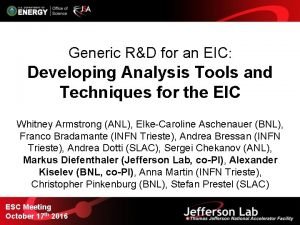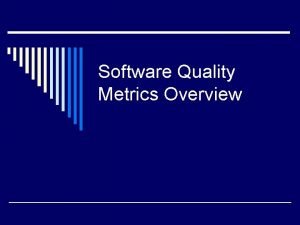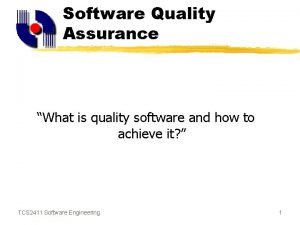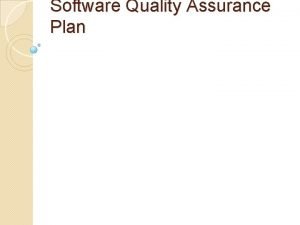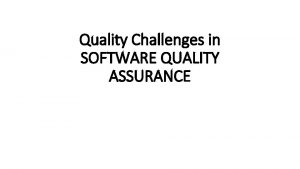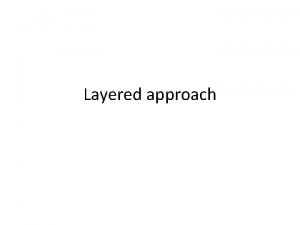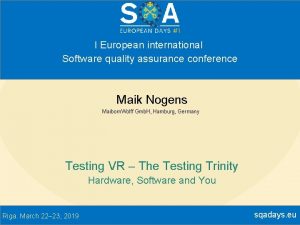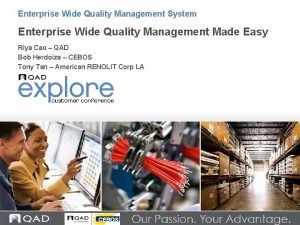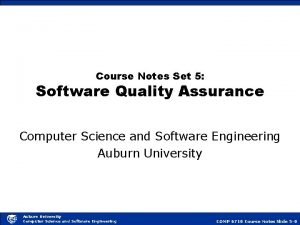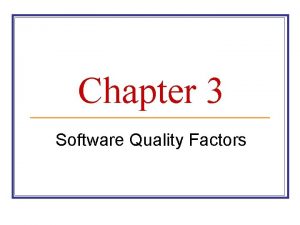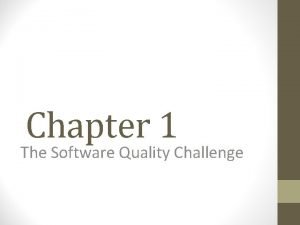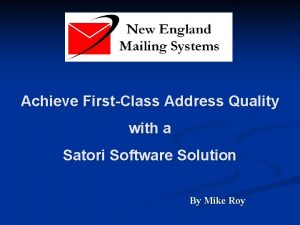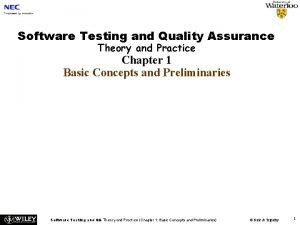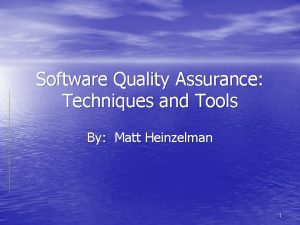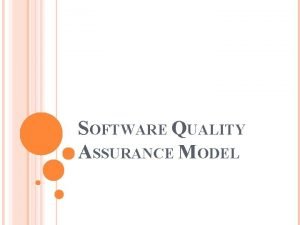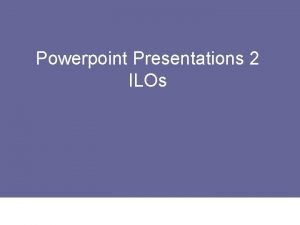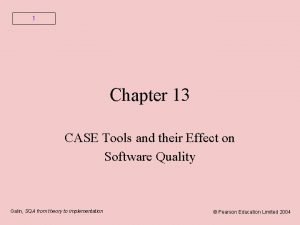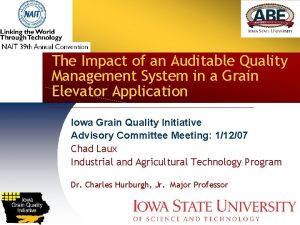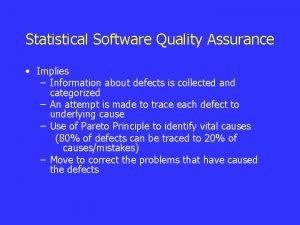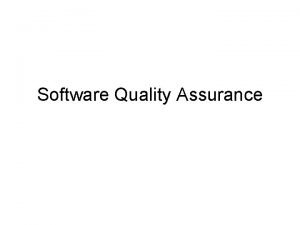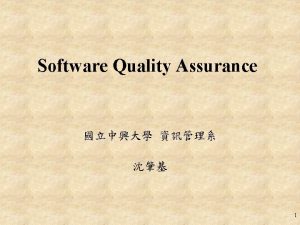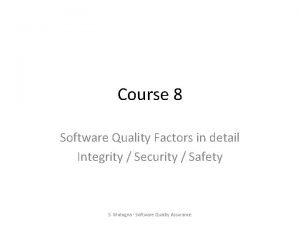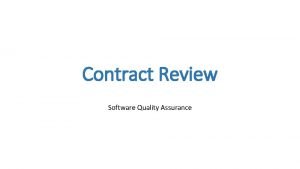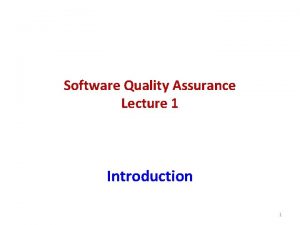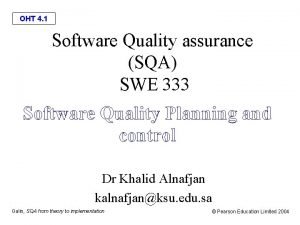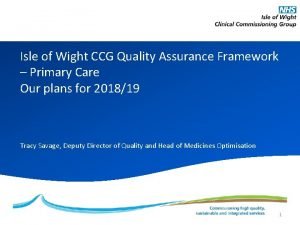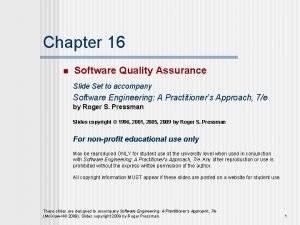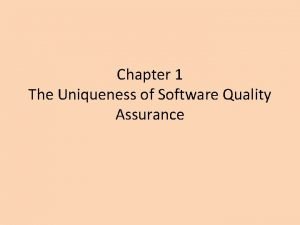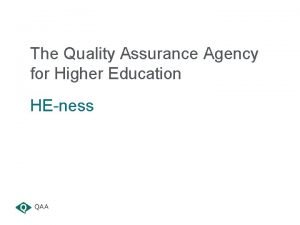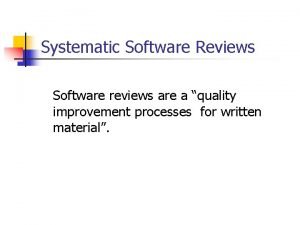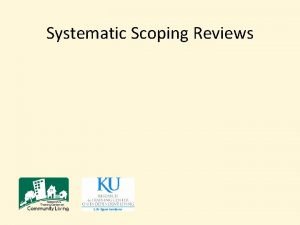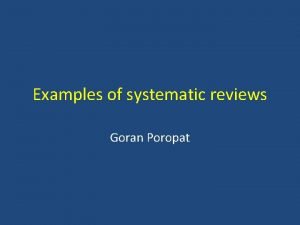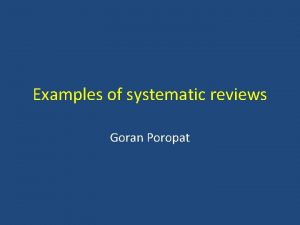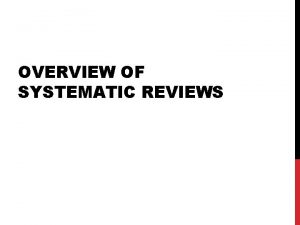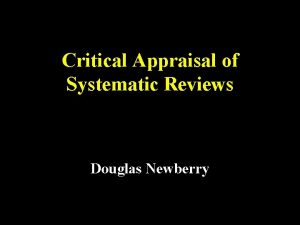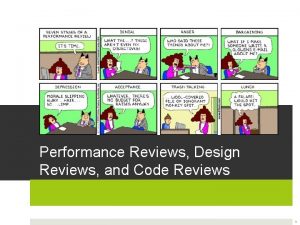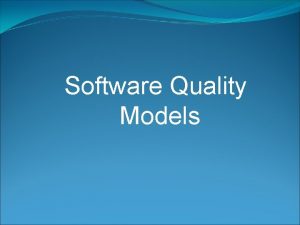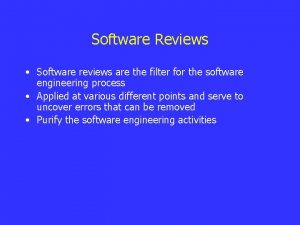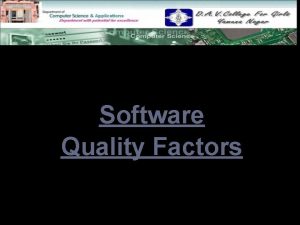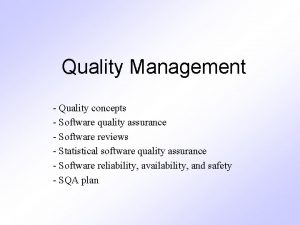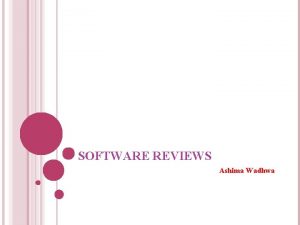Systematic Software Reviews Software reviews are a quality











































- Slides: 43

Systematic Software Reviews Software reviews are a “quality improvement process for written material”. © Michael Crosby and Charles Sacker, 2001

Goal and Motivation: By detecting defects early, and preventing their leakage downstream, the higher cost of later detection and rework is eliminated. © Michael Crosby and Charles Sacker, 2001

Basic Steps: • • • Using a static analysis technique, Perform a visual examination of the software products Detect and correct: • • • Defects Violation of design standards Other problems © Michael Crosby and Charles Sacker, 2001

What is a Software Product The term “software product” is used in a very broad sense to describe any document produced during the software lifecycle. © Michael Crosby and Charles Sacker, 2001

Examples of Software Products Include: n n n n Contracts Installation plans Progress reports Software design descriptions Release notes Software requirements specifications Source code © Michael Crosby and Charles Sacker, 2001

What Is a Defect? n n n Any occurrence in a work product that is determined to be incomplete, incorrect, or missing Any instance which a requirement is not satisfied(Fagan, 1986) Informal synonyms: bug, fault, issue, problem, anomaly © Michael Crosby and Charles Sacker, 2001

Common Attributes: Systematic reviews have these attributes in common: • • • Team participation Documented results of the review Documented procedures for conducting the review © Michael Crosby and Charles Sacker, 2001

Industry Experience With Reviews n Aetna Insurance Company: n n Bell-Northern Research: n n Inspection cost: 1 hour per defect. Testing cost: 2 -4 hours per defect. Post-release cost: 33 hours per defect. Hewlett-Packard n n FTR found 82% of errors, 25% cost reduction. Est. inspection savings (1993): $21, 454, 000 IBM n n C system software No errors from time of first compile. © Michael Crosby and Charles Sacker, 2001

Inspections vs. Reviews The IEEE Standard for Software Reviews defines 5 types of review: • • • Management Reviews Technical Reviews Inspections (Formal Peer Review) Walk-throughs Audits © Michael Crosby and Charles Sacker, 2001

Details of the Five Types of Software Review © Michael Crosby and Charles Sacker, 2001

Management Review Overview n n n Performed by those directly responsible for the system Monitor progress Determine status of plans and schedules Confirm requirements and their system allocation Or, evaluate management approaches used to achieve fitness or purpose © Michael Crosby and Charles Sacker, 2001

Management Review Overview Continued Support decisions made about: • • • Corrective actions Changes in the allocation of resources Or changes to the scope of the project. © Michael Crosby and Charles Sacker, 2001

Management Reviews Continued Software products reviewed n n n Audit Reports Contingency plans Installation plans Risk management plans Software Q/A © Michael Crosby and Charles Sacker, 2001

Management Review Roles Required: • • • Decision Maker Review Leader Recorder Management Staff Technical Staff © Michael Crosby and Charles Sacker, 2001

Management Review Outputs Documented evidence that identifies: • • Project under review Review team members Review objects Software product reviewed Inputs to the review Action item status List of defects identified by the review team © Michael Crosby and Charles Sacker, 2001

Technical Review Overview Confirms that product n n Conforms to specifications Adheres to regulations, standards, guidelines, plans Changes are properly implemented Changes affect only those system areas identified by the change specification © Michael Crosby and Charles Sacker, 2001

Technical Reviews Continued Software products subject to technical reviews • • • Software requirements specification Software design description Software test documentation Software user documentation Installation procedure Release notes © Michael Crosby and Charles Sacker, 2001

Technical Review Roles The roles established for the technical review • • Decision maker Review leader Recorder Technical staff © Michael Crosby and Charles Sacker, 2001

Technical Review Outputs, documented evidence that identifies: • • • Project under review Review team members Software product reviewed Inputs to the review Review objectives and status List of resolved and unresolved software defects List of unresolved system or hardware defects List of management issues Action item status Recommendations for unresolved issues Whether software product meets specification © Michael Crosby and Charles Sacker, 2001

Inspections (Formal Peer Reviews) Confirms that the software product satisfies n n Specifications Specified quality attributes regulations, standards, guidelines, plans Identifies deviations from standard and specification Failure to do so results in logging a defect © Michael Crosby and Charles Sacker, 2001

Inspections Continued Software products subject to Inspections • • Software requirements specification Software design description Source code Software test documentation Software user documentation Maintenance manual Release notes © Michael Crosby and Charles Sacker, 2001

Inspection Roles The roles established for the Inspection • • • Inspection leader Recorder Reader Author Inspector © Michael Crosby and Charles Sacker, 2001

Inspection Outputs, documented evidence that identifies: • • • Project under inspection Inspection team members Inspection meeting duration Software product inspected Size of the materials inspected Inputs to inspection Inspection objectives and status Defect list (detail) Defect summary list Disposition of the software product Estimate of the rework effort and completion date © Michael Crosby and Charles Sacker, 2001

Walk-throughs • • • Evaluate a software product Sometimes used for educating an audience Major objectives: • • Find anomalies Improve the software product Consider alternative implementations Evaluate performance to standards and specs © Michael Crosby and Charles Sacker, 2001

Walk-throughs Continued Software products subject to walk-throughs • • Software requirements specification Software design description Source code Software test documentation Software user documentation Maintenance manual Release notes © Michael Crosby and Charles Sacker, 2001

Walk-through Roles The roles established for Walk-throughs • • Walk-through leader Recorder Author Team member © Michael Crosby and Charles Sacker, 2001

Walk-through Outputs The outputs of the walk-through • • Walk-through team members Software product being evaluated Statement of objectives and their status Recommendations made regarding each anomaly List of actions, due-dates, responsible parties Recommendations how to dispose of unresolved anomalies Any proposal for future walk-throughs © Michael Crosby and Charles Sacker, 2001

Audits The purpose of an audit is to provide an independent evaluation of conformance of software products and processes to applicable; n n n Regulations Standards Guidelines Plans Procedures © Michael Crosby and Charles Sacker, 2001

Inspection Process Most popular is the Fagan method n n Inspection is separated into 5/6 phases n n n (Planning) Overview Preparation Inspection Meeting Rework Follow-up © Michael Crosby and Charles Sacker, 2001

Inspection Materials n n n n Source Document Checklist Supporting Documents Invitation Master Plan Issue/Defect Log Data Summary © Michael Crosby and Charles Sacker, 2001

Planning/Overview n n © Michael Crosby and Charles Sacker, 2001 Inspectors are selected Roles are assigned Documents are distributed General inspection task is discussed

Inspection Roles © Michael Crosby and Charles Sacker, 2001

Roles: Leader n n n n Manages inspection Acts as moderator Determines document worthiness Identifies/invites inspectors Assigns roles Distributes documents Schedules meeting times/locations © Michael Crosby and Charles Sacker, 2001

Roles: Author n n Creates the document for inspection Assists with answering questions Typically not directly involved in inspection Makes corrections to document if necessary © Michael Crosby and Charles Sacker, 2001

Roles: Inspector n n n Complete familiarization of document on time Inspect document(s) for defects Look for assigned defects (if appropriate) Make use of checklists or other supporting documents Contact leader early if problems arise or if the inspection might be a waste of time © Michael Crosby and Charles Sacker, 2001

Roles: Scribe/Recorder n n n Records issues as they are raised Ideally not the moderator or inspector Record information legibly © Michael Crosby and Charles Sacker, 2001

Preparation n n © Michael Crosby and Charles Sacker, 2001 Inspectors acquaint themselves with the documents to be inspected Need to be familiar with material in time for inspection meeting

Inspection Meeting n n n © Michael Crosby and Charles Sacker, 2001 Inspection team attempts to locate defects Defects are not fixed at this point Meeting < 2 hours long!

Inspection Meeting (cont. ) n n Round-robin approach or Reader approach Scribe records all issues n n n Where defect was located Why is it a defect (cite requirement or checklist) Suggested severity level (Major, minor) Do Not record names of inspectors with defect Try to make visible to all participants (avoid duplication) © Michael Crosby and Charles Sacker, 2001

Rework n n n © Michael Crosby and Charles Sacker, 2001 Author receives defect log Identifies true defects vs. “false positives” Fixes defects, provides justification for false positive

Follow-Up n n © Michael Crosby and Charles Sacker, 2001 Leader verifies all defects have been addressed Decides if document passes inspection or if another inspection is necessary

Inspection Process © Michael Crosby and Charles Sacker, 2001

Review Pitfalls n n n Insufficient Preparation Moderator Domination Incorrect Review Rate Ego-involvement and Personality Conflict Issue Resolution and Meeting Digression Recording Difficulties and Clerical Overhead © Michael Crosby and Charles Sacker, 2001
 Mikael ferm
Mikael ferm Prospero systematic reviews
Prospero systematic reviews Quality control and quality assurance
Quality control and quality assurance Pmp quality management
Pmp quality management Quality metrics pmp
Quality metrics pmp Quality assurance model in nursing
Quality assurance model in nursing Compliance vs quality
Compliance vs quality Basic concept of quality management
Basic concept of quality management Quality gurus meaning
Quality gurus meaning Crosby quality is free
Crosby quality is free What is tqm
What is tqm Physics engine software reviews
Physics engine software reviews Eic software reviews
Eic software reviews Software quality and metrics
Software quality and metrics Software quality infrastructure components
Software quality infrastructure components Software quality assurance iso standards
Software quality assurance iso standards Quality assurance plan software
Quality assurance plan software Software quality challenges
Software quality challenges Quality focus in software engineering
Quality focus in software engineering Software quality assurance conference
Software quality assurance conference Enterprise wide quality integrated management solution
Enterprise wide quality integrated management solution Software quality assurance notes
Software quality assurance notes Which quality factor comes in product revision category
Which quality factor comes in product revision category The software quality challenge
The software quality challenge Satori bulk mailer
Satori bulk mailer Software testing and quality assurance: theory and practice
Software testing and quality assurance: theory and practice Quality revolution in software testing
Quality revolution in software testing Sqa tools and techniques
Sqa tools and techniques Software quality assurance models
Software quality assurance models Statistical quality assurance in software engineering
Statistical quality assurance in software engineering Quality assurance powerpoint
Quality assurance powerpoint Classic case tools
Classic case tools Quality management software for farmers
Quality management software for farmers Statistical software quality assurance
Statistical software quality assurance Statistical sqa
Statistical sqa Computer software assurance
Computer software assurance Cwe mitre
Cwe mitre Sqa checklist
Sqa checklist Introduction to software quality assurance
Introduction to software quality assurance Software quality control checklist
Software quality control checklist The isle quality assurance
The isle quality assurance Software quality assurance slideshare
Software quality assurance slideshare Uniqueness of software quality assurance
Uniqueness of software quality assurance Software quality assurance agency
Software quality assurance agency












